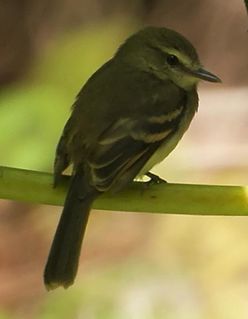
The fuscous flycatcher is a small passerine bird in the tyrant flycatcher family, and the only member of the genus Cnemotriccus. It breeds from Colombia and Venezuela south to Bolivia, Paraguay and Argentina, and on both Trinidad and Tobago. The fuscous flycatcher ranges in northern and eastern South America, including the entire Amazon Basin, and the Guianas; also all of Brazil except the very southeastern border area with Uruguay.

Apamea remissa, the dusky brocade, is a moth of the family Noctuidae. It is distributed throughout Europe and Turkey, ranging across the Palearctic ecozone to Siberia, Manchuria and Japan. It has also been reported from Alaska.
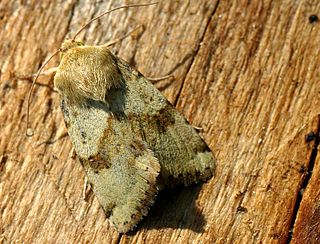
Heliothis viriplaca, the marbled clover, is a moth of the family Noctuoidea. It is found in Europe and across the Palearctic to Central Asia then to Japan, Korea and Sakhalin. In the south, it penetrates to Kashmir and Myanmar. As a migratory butterfly, it also reaches areas in northern Fennoscandia in some years. North of the Alps, both indigenous and immigrant individuals occur in certain areas. The heat-loving species occurs mainly on dry grasslands, fallow land, heathlands and sunny slopes and slopes and the edges of sand and gravel pits.

Paradrina clavipalpis, the pale mottled willow, is a moth of the family Noctuidae. The species was first described by Giovanni Antonio Scopoli in his 1763 Entomologia Carniolica. It is found in the Palearctic ecozone. It is an introduced species in North America, where it was first reported from Queens in New York City in 1993. In 2009 it was found in Rochester, New York, so it appears to be established and spreading.
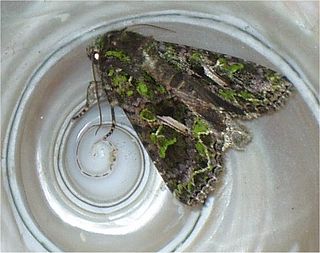
The Orache Moth(Trachea atriplicis) is a species of moth of the family Noctuidae. It is found in all of Europe, east across the Palearctic to the Pacific Ocean and Japan.

Anania crocealis is a species of moth of the family Crambidae. It was described by Jacob Hübner in 1796 and is found in Europe.

Coleophora serratella is a moth of the family Coleophoridae. It is found in Europe, Japan (Hokkaido) and North America.

Mesapamea secalis, the common rustic, is a moth of the family Noctuidae. The species was first described by Carl Linnaeus in his 1758 10th edition of Systema Naturae. It is found in Europe, north-west Africa, Turkey and northern Iran.

Agrotis vestigialis, the archer's dart, is a moth of the family Noctuidae. The species was first described by Johann Siegfried Hufnagel in 1766. It is found in most of the Palearctic ecozone from Ireland east, through to Russia, Siberia, the Altai mountains and the Amur region. Also in the Mediterranean area. It is absent from the north of Finland and Norway,

Grammodes stolida, the geometrician, is a moth of the family Erebidae. The species was first described by Johan Christian Fabricius in 1775. It is found in Africa, southern Europe, most of Asia and Australia. It migrates to central and northern Europe as far north as England, Denmark and Finland.

Agrotis trux, the crescent dart, is a moth of the family Noctuidae. The species was first described by Jacob Hübner in 1824. It has a circum-Mediterranean distribution and is found along the coasts of France, Ireland, England, southern Europe, Algeria, Syria, Iraq, Iran, southern Russia and the Arabian Peninsula. In Africa, it is found as far south as South Africa.
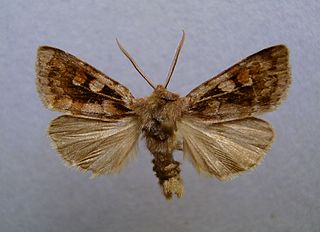
Xestia alpicola, the northern dart, is a moth of the family Noctuidae. It is found from northern Europe across the Palearctic to central Siberia and in the Alps.

Spaelotis ravida, the stout dart, is a moth of the family Noctuidae. The species was first described by Michael Denis and Ignaz Schiffermüller in 1775. It is found in the Palearctic ecozone.
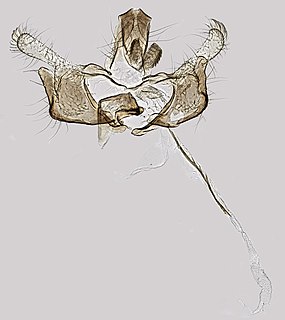
Coleophora betulella is a moth of the family Coleophoridae. It is found in all of Europe, except the Balkan peninsula.

Adela croesella is a moth of the Adelidae family. It is found in most of Europe.

Stigmella alnetella is a moth of the family Nepticulidae. It is found in all of Europe, except the Balkan Peninsula.

Athetis pallustris, the marsh moth, is a moth of the family Noctuidae. It is found in most of Europe, the southern Urals, southern Russia, Ukraine, eastern Turkey, Siberia, the Amur region,the Russian Far East, Mongolia and northern China.

Enteucha acetosae, the pygmy sorrel moth, is a moth of the family Nepticulidae. It is found from Sweden to the Pyrenees, Alps and Serbia and from Ireland to Romania.
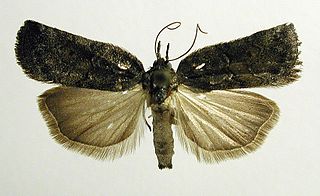
Nycteola revayana, the oak nycteoline, is a moth of the family Nolidae. The species was first described by Giovanni Antonio Scopoli in 1772. It is found from Europe and east across the Palearctic to Japan and India.
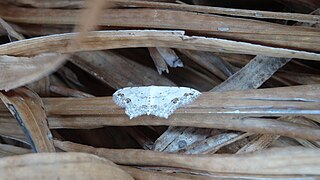
Scopula pulchellata is a moth of the family Geometridae. It is found in the Indo-Australian tropics, from India, Sri Lanka to Taiwan and the Solomon Islands, as well as in Africa.



















